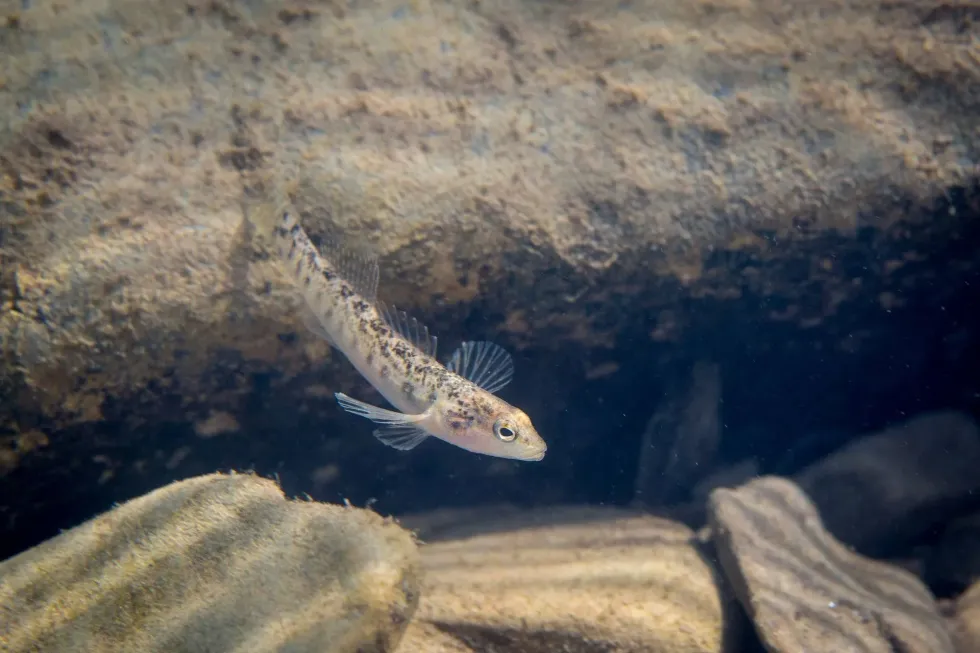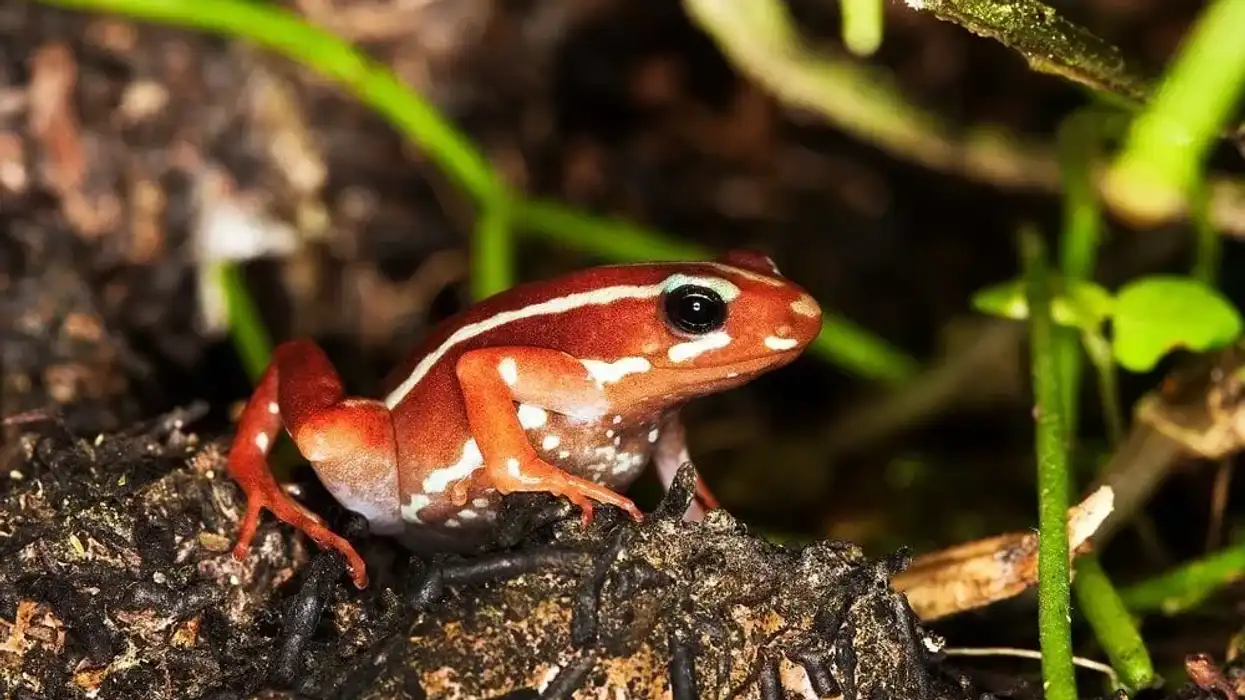The fantail darter (Etheostoma flabellare) is a slender fish that lives up to four years of age. With sandy yellow scales and black spots, it can readily camouflage into the rocky river beds.
The distribution of these fish ranges across the North American rivers and streams up to South Carolina. Species native to Carolina are locally known as Carolina fantail darter. Relying mostly on an insectivorous diet, these fish are great aquatic predators.
Their eggs are medium in size and each egg takes up to three days to hatch into young darters who become independent hunters in no time. A male is protective of the eggs that the female hatches and shelters them on the underside of submerged rocks.
Intrigued about the fantail darters? Read on to know more interesting facts about this fish species. Also, check out interesting facts about clownfish and piranhas.
Fantail Darter Interesting Facts
What type of animal is a Fantail Darter?
The fantail darter (Etheostoma flabellare) is a fish species native to North American rivers.
What class of animal does a Fantail Darter belong to?
A fantail darter fish belongs to the class of Actinopterygii. They belong to the Etheostoma genus which means 'having various mouths'.
How many Fantail Darters are there in the world?
At present, fantail darters are only found in North America. The population of this species is found in great numbers all across North American rivers, but the exact population size of this fish is not known.
Where does a Fantail Darter live?
The fantail darter is found to live in rivers and is a freshwater fish. The most suitable areas are on the shallow river beds filled with rocks, boulders, and pebbles, on the water riffles, and closer to the water's surface. They are only found to live in temperate river waters.
What is a Fantail Darter's habitat?
The native habitat range of this fish is in North American rivers and lakes. They are widely found in the Great Lakes region, South Carolina, Alabama, and Oklahoma. They are found to live in the shallow parts of streams and creeks, residing mostly underneath flat cobbles, pebbles, and limestone beds.
Who do Fantail Darters live with?
The fantail darters prefer living by themselves but gang up in shoals in times of hunting prey. Also, the males are more protective of the eggs and take care of them until they hatch. Many males come together in a shoal to attract a female partner or to take care of their young.
How long does a Fantail Darter live?
The lifespan of a fantail darter (Etheostoma flabellare) is up to four years old in the wild.
How do they reproduce?
A male and a female become sexually mature by the time they are one or two years old, thereafter the spawning starts. Both males and females mate with multiple partners during this time. A male attracts a female with its bulbous egg-like dorsal fin.
Ideally, spring is the spawning season. The female nest 50 to 300 eggs per spawning season on the underside of the rocks to protect from predators. The overprotective male guards the eggs until they hatch into young darters.
What is their conservation status?
The fantail darter (Etheostoma flabellare) is listed as of Least Concern on the IUCN Red List. Being a riverine fish it is prone to microclimatic fluctuations like the temperature changes of the rivers and the changes in water level.
These fish are capable of withstanding these riverine changes and emerge as the keystone species, maintaining their population size in all localities. So apart from major climatic changes, their survival is not threatened by any other sources.
Fantail Darter Fun Facts
What do Fantail Darters look like?

A fantail darter has a slender body having brown, sandy-yellow to olive-green skin color with black dots. The dorsal fin on both sides of its body is spiny and with between seven and nine dorsal-fin rays present on either side.
The tail of this fish also has black dots with the males having 10 to 15 more prominent black bands than the females.
The mouth of this species is upturned and is darker in color than the rest of its body. Among the fantail darter gender differences, the most striking is the bulbs on the fins of a male that look like an egg that remains absent in the female body.
How cute are they?
The distribution of these slim fishes is found widely in the North American rivers. While most people find them unattractive, some find them cute. Some like their slender stature and sandy yellow to brown body color.
How do they communicate?
Usually, they swim on their own playfully roaming in the water. However, at the time of spawning, the males and females become active and open to communication.
The males attract the females with their bulbs, like that of eggs present on the dorsal fin. The females readily swim up to the males to communicate and mate with them. Apart, from this, these fishes avoid much communication with the other fish species.
How big is a Fantail Darter?
The average fantail darter size is 3.25 in (8.4 cm). A fantail darter is three times the size of a goldfish and eight times smaller than a lobster.
How fast can a Fantail Darter swim?
They are fast swimmers who prefer to reside in the shallow waters of big rivers and at the gravel bottom of small streams. However, the exact swimming speed of this fish is yet to be ascertained.
How much does a Fantail Darter weigh?
The weight of this medium-sized fish is negligible. Hence, the approximate weight of these darters is not known.
What are the male and female names of the species?
In terms of the fantail darter gender differences, the male and female darter fantail do not have any separate names assigned.
What would you call a baby Fantail Darter?
Baby fantail darters can be called as it is. Or they are known as nymphs and larvae.
What do they eat?
The diet of both the male and female fish consists mostly of various insects as food present in water. Other food sources include mayflies, caddisfly, dipteran, copepods, cladoceran, amphipods, gastropods, isopods, and midge larvae.
Just after the eggs hatch and the young larvae become two to three days old, they become good predators and start hunting their food on their own. Due to fluctuating river temperatures and turbidity, their food supply diminishes making them repopulate to other places to maintain their diet.
Are they poisonous?
Fantail darters are harmless to humans but they are the keystone species of the rivers and streams. Hence, they are great predators of insects, fish, and other food. They nest beside rocks and gravel almost becoming invisible to their prey because of their sandy brown body color.
Would they make a good pet?
Since they prefer to stay around the river riffles, underwater rocks, and gravel, a similar habitat range is hard to create in a home aquarium. This may adversely affect their age and reduce the longevity of their life.
Also, for the spawning of the eggs, the males and females prefer staying near flat rock surfaces whereby the females can easily attach the eggs to the rock underside.
Hence, keeping them as pets at home isn't a good idea. Also, supplying them with food like insects, fish larvae, and nymphs to maintain their diet isn't possible at home.
Did you know...
The overprotective male fathers otherwise protecting the egg can turn into a cannibal eating up a few eggs when the food supply is less to keep up with their diet.
While the spawning position is from head to toe, the male remains upright but the female turns inverted.
The head and tail fin of a male fantail darter are darker in color than the females.
What type of mouth does a Fantail Darter have?
The head, body, and tail of the Etheostoma flabellare are aligned in a straight line giving it a slender appearance. Each dorsal fin helps it to swim swiftly and also to bash and injure its prey with a single swipe.
The mouth of the fantail darter is small and they have canine teeth to bite their food. The most striking feature is that its mouth is upturned which enables it to catch insects easily and to derive oxygen from water.
How did the Fantail Darter get its name?
From the fantail darter's scientific name Etheostoma flaballare, the fish has derived its name. Etheostoma flaballare means a fish having various mouths and a fan-shaped tail.
Here at Kidadl, we have carefully created lots of interesting family-friendly animal facts for everyone to discover! Learn more about some other fish including toadfish facts and cichlid facts.
You can even occupy yourself at home by coloring in one of our free printable fantail darter coloring pages.










